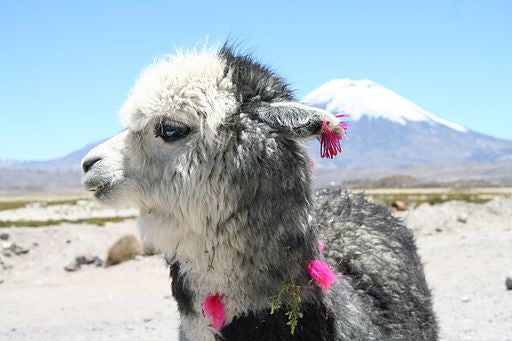Know Your Fiber: Alpaca
Posted on June 01 2017

If you have spent any time at all in a yarn shop, you have probably seen alpaca and alpaca-blend yarns, and marveled at their softness. Alpacas are in the camelid family -- the same biological family as camels and llamas.
Although they can be found around the world today, alpacas originated in the Andes mountain range of South America. They are descended from vicuña, a wild camelid native to South America, in the Andes mountain range. The domestication of the alpaca for fiber and meat began up to 6000 years ago, with the people who lived in the Andes.
Alpacas were treasured in Incan civilization, and their fiber was considered to be the most valuable fiber available. They were exclusively bred for fiber and meat, and breeding lines were carefully monitored by the Incan government to ensure health and fiber quality. Sadly, with the arrival of Spanish conquistadors, an estimated 90% of these animals were killed by soldiers as a part of their campaign to take over Incan lands.
The remaining alpacas were kept from extinction by communities in the Andes, who continued to breed them. It was not until the mid 1800s that alpaca fiber started to become recognized in Europe for its fine fiber and softness. Sir Titus Salt of England was a huge fan of alpaca, and advocated for its use in European clothing. He helped to establish its use in textile mills, and promoted it to European fashion houses. However, even with its burgeoning popularity, the production of alpaca fiber remained in South America. Some attempts were made to import and raise alpacas in Australia during the 1800s, but these attempts ended in failure.
It wasn't until the 1980s that successful alpaca husbandry made its way out of South America. In 1984, the United States imported their first successful alpaca herds. Australia and New Zealand followed suit in 1989.
Even with the successful establishment of alpacas outside of South America, most of today's alpaca fiber production still occurs there. Although several South American countries have a thriving alpaca industry, the majority of South American alpacas are located in Peru; there are estimated to be 2.5 million of them there. There are two distinct breeds of alpaca today: Suri alpaca with their long, fluffy locks, and Huacaya alpaca with their fluffy, short and dense fiber.
Alpaca is a wonderfully cozy and warm fiber. Alpaca hairs are hollow, making it a go-to fiber for crafters and manufacturers who are looking for softness with superior insulating properties. It is also surprisingly strong for such a soft, fluffy fiber.
Alpaca fiber comes in various qualities, ranging from fibers nearly as soft and luxurious as cashmere to lower quality fibers with a similar texture to fine wool. Most yarn and spinning fiber available relies on the high quality, fine alpaca. It is more difficult to find coarser alpaca, as there is little demand for it in North America. Alpaca is also hypoallergenic, making it very popular for people with skin sensitivities.
Stop on in the store or check our online shop for our alpaca! If you have not already used this fiber, we are confident that you will love it. If you have already used it, well, come on down and stock up on some more!

Follow US